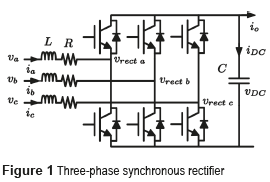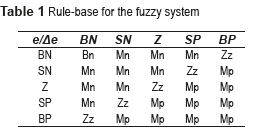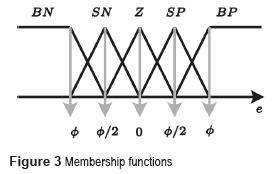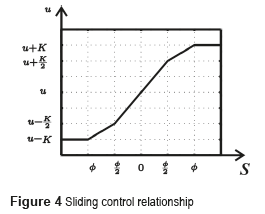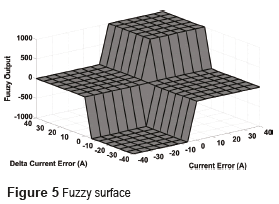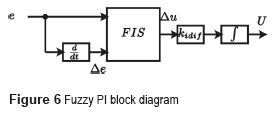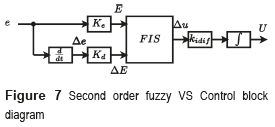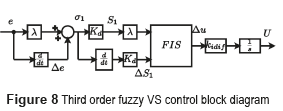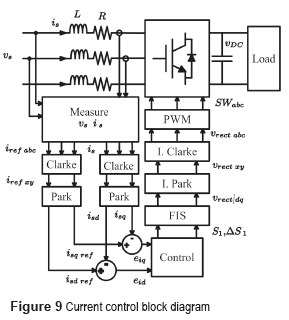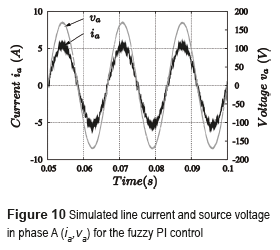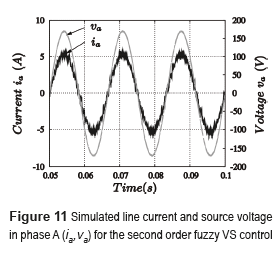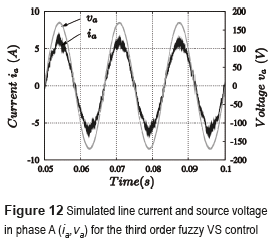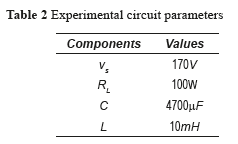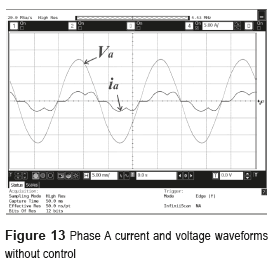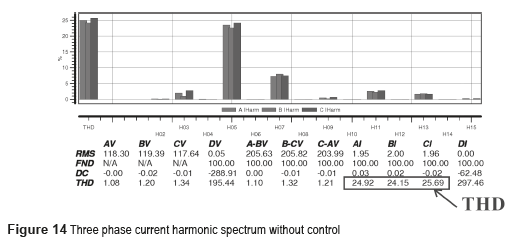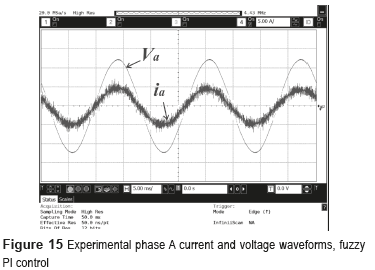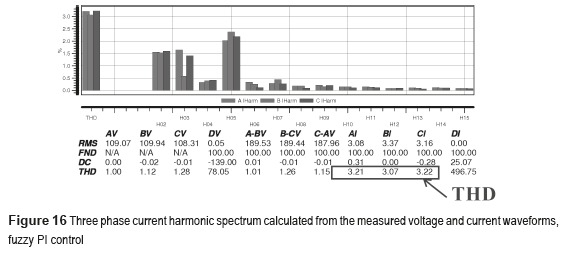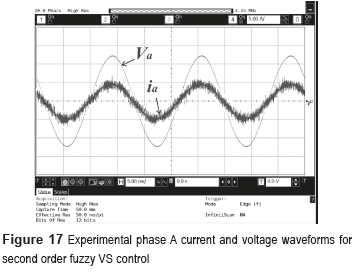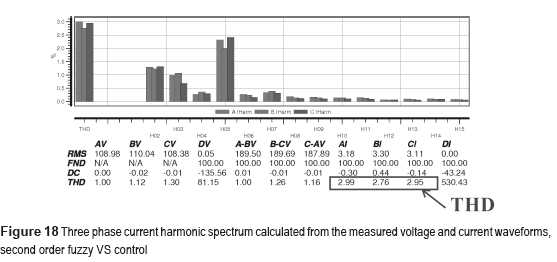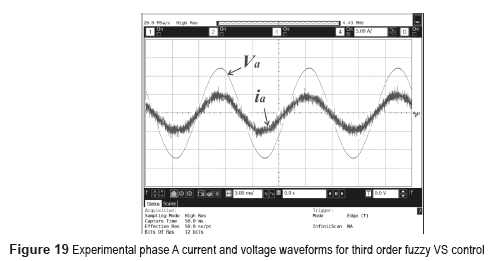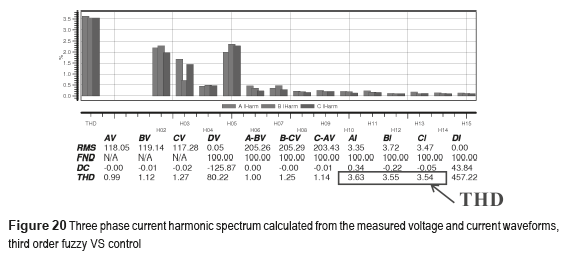Services on Demand
Journal
Article
Indicators
-
 Cited by SciELO
Cited by SciELO -
 Access statistics
Access statistics
Related links
-
 Cited by Google
Cited by Google -
 Similars in
SciELO
Similars in
SciELO -
 Similars in Google
Similars in Google
Share
Revista Facultad de Ingeniería Universidad de Antioquia
Print version ISSN 0120-6230
Rev.fac.ing.univ. Antioquia no.74 Medellín Jan./Mar. 2015
ARTÍCULO ORIGINAL
Fuzzy control techniques applied to a three phase synchronous rectifier current loop
Técnicas de control difuso aplicadas al lazo de corriente de un rectificador síncrono trifásico
Alberto Berzoy-Llerena, Victor Manuel Guzman-Arguis*, Maria Isabel Gimenez de Guzman, Jose Restrepo-Zambrano, Jose Manuel Aller-Castro
Departamento de Electronica y Circuitos, Universidad Simon Bolívar. Valle de Sartenejas, Municipio Baruta, Estado Miranda, 1080. Apartado 89000. Caracas, Venezuela.
* Corresponding author: Victor Manuel Guzman Arguis, e-mail: vguzman@usb.ve
(Received October 16, 2013; Accepted November 10, 2014)
Abstract
This work presents three fuzzy variable structure control (FVSC) techniques applied to the current control loop in a three-phase synchronous rectifier. These techniques are based in a Takagi-Sugeno (T-S) fuzzy PI controller. The first controller is a first-order FVSC, used as a reference. Then, two FVSC strategies are presented and tested, a second and a third-order FVSC. These control schemes are first simulated and then tested in a general-purpose laboratory synchronous rectifier test bench. Experimental results show that control performance is good in all three schemes, achieving current harmonic compensation and power factor correction.
Keywords: FIS Takagi-Sugeno, fuzzy control, three phase synchronous rectifier control, power factor correction
Resumen
Este trabajo presenta tres técnicas de control difuso de estructura variable (FVSC) aplicadas al lazo de control de corriente en un rectificador síncrono trifásico. Estas técnicas se basan en un controlador PI difuso Takagi-Sugeno (T-S). El primer controlador es un FVSC de primer orden que se usa como referencia. A continuación se presentan y prueban dos estrategias FVSC, FVSC de segundo y tercer orden. Estos esquemas de control se simulan primero y luego se prueban en un rectificador síncrono de propósito general de laboratorio. Los resultados experimentales muestran que el rendimiento del control es bueno en los tres esquemas, logrando compensación de las corrientes armónicas y corrección del factor de potencia.
Palabras clave: FIS Takagi-Sugeno, control difuso, control de rectificadores síncronos trifásicos, corrección del factor de potencia
Introduction
Research on three-phase synchronous rectifiers has been increasing in the last decade due to its usefulness in motor control [1], power supply systems [2, 3] and reactive power control systems [4-7]. Several diverse and complex control techniques exist for the three-phase synchronous rectifier in specific areas [8-15], and many modulation techniques for these converters are reported in literature [16, 17].
Synchronous rectifiers are important in reducing AC supply line current harmonic contamination [1-20], in power factor correction [1-18], in compensating load unbalances [21, 22], and finally, in line conditioning [23-25]. Harmonic contamination is increasingly important due to the huge number of electronic equipments in use, each one representing a non-linear load connected to the AC supply. These non-linear loads draw more reactive power and increase the losses in the transmission system. The ever increasing harmonic content in the line current also causes electromagnetic interferences and, occasionally, dangerous resonances. Non-linear loads and non-sinusoidal currents increase voltage harmonic distortion in network impedances, overheating the transmission lines, the transformers and the generators.
Previous works by different authors have implemented fuzzy techniques in three-phase synchronous rectifiers. In [26] a fuzzy system controlling an active filter's DC link voltage is simulated in MATLAB but no experimentally tested, furthermore the internal line-current control loop is done through PI controllers. In [27] a fuzzy inference system is used to regulate the limiter of a PI current controller. The work proposed in [27] does not present experimental results and the tuning of this strategy appears to be complicated due to the amount of parameters like Kp, Ki from PI controller and the 81 rules and membership functions of the limiter. In [28] a first-order fuzzy inference system Takagi-Sugeno is simulated, however there are not experimental results and there is no explanation of how to find the constants ''a'' and ''b'' in the fuzzy-rules. In [29] it is presented the simulation and experimental results for a fuzzy system controlling the DC link voltage; however, the inner current loop is not explained. The study in [30] simulates a line current fuzzy hysteresis band scheme for active power filter, but it does not present experimental results. The author used a PI controller for the DC link and even when the fuzzy rules are very similar to Fuzzy PI rules, the article does not make any reference to MacVicar-Whelan rules. Simulation and experimental results of a fuzzy controller to auto-modulate the parameters Kp, Ki and Kd in a line-current PID controller are shown in [31]. Finally, in [32] it is presented a MATLAB simulation of a first-order fuzzy variable structure controller for the line-current although did not report experimental results.
This work presents three control schemes for the input current and the DC link voltage in a three phase synchronous rectifier. These control schemes are: fuzzy PI control (first order FVSC1), second order fuzzy variable structure control (FVSC2) and third order fuzzy variable structure control (FVSC3) [33]. In each case, the target is to impress a sinusoidal input current in the three-phase synchronous rectifier. This current must also be in phase with the grid voltage following a specific magnitude reference for the line current. This set point will minimize current harmonic distortion, ensuring unity power factor. Among the advantages of the fuzzy controller are:
1) Unlike DPC [5] and PI controllers, this one does not need an accurate mathematical model.
2) It is independent of input circuit parameters such as choke inductance and line resistance.
3) It can work with imprecise inputs since the sliding control criteria include disturbances and uncertainties [33, 34].
4) It can handle non-linearities since its fuzzy control rules can be automatically changed according to the instantaneous changes in the system state, managing the nonlinearity and uncertainty of power systems.
5) It is more robust than conventional controllers such as PID.
6) The FVSC dynamic response is better than those of conventional PI controllers, since the fuzzy PI controller uses the derivative of the error. This improves the settling time and also limits the controlled variable overshoot.
7) It improves the THD in comparison with other controllers such as DPC.
8) The FVSC is based in a T-S fuzzy PI controller, which can be programmed as a function to make it more versatile. It can be re-used for the two inner-current control loops (direct and quadrature component) and for the external DC link loop. It can be implemented in dq, xy and abc reference frames. Furthermore, it can be reused in other power applications as DC/DC converters [35]. In addition, the fuzzy PI controller can easily be dimensioned, by just changing the number of membership functions. That dimensioning depends on the memory capacity of the microcontroller, DSP or processing unit employed.
9) The proposed control is implemented in the dq reference frame, which can be easily expanded to control the active and reactive power [23], since the direct component is proportional to active power and the quadrature one is proportional to reactive power.
10) T-S fuzzy inference system has two advantages over the Mandani-type fuzzy controller in the following aspects: a) Mandani needs fuzzy sets used for the de-fuzzification of the output and T-S is a direct procedure to find the output; b) Computation time.
The schemes proposed in this article are controllers that follow a reference current template generated from the line-voltage. The line-voltage is measured in ''abc'' coordinates, and the reference current template is shown in equation (1):

Where kiref has a value between 0 and 1 A/V and represents the current magnitude as a percent of the line-ground voltage. The nominal voltage of vsa is 170V. For example, kiref = 0.01A/V means that the ia line current magnitude will be 1,7A, which is 1% of 170V.
This article compares three different control schemes for the input current. All these techniques use a Takagi-Sugeno inference system; they are first simulated and later verified with a laboratory synchronous rectifier prototype. The digital simulations run in Simulink MATLAB. The experimental test bench is based on the system described in [36]. This test bench uses an ADSP-21369 processor.
Three-phase synchronous rectifier
Figure 1 shows the voltage source three-phase synchronous rectifier building blocks: an inductive input coupling, a three-phase IGBT inverter bridge and a capacitive DC bus output filter.
The circuit is modeled with the following equation (2):

Where, are space vectors defined by the Clarke transformation in (3):
are space vectors defined by the Clarke transformation in (3):

In equation (3)
Control strategies principles
A. Classic variable structure control (VSC)
The basic principles for a classic variable structure control are discussed in [34, 37, 38]. The main idea in this section is to show the similarities of the ''sliding control'' [39-42] and fuzzy control.
A second order system can be represented as (4).

Where ''x'' is the state vector, ''u'' is the control variable, ''d'' represents the disturbances and f(x,t) is a non-linear function of the state vector.
The surface S is described in (5).

Where ''e'' is the error of the state vector,  is the first error derivative and λ is a constant value. The Error ''e'' is defines in (6).
is the first error derivative and λ is a constant value. The Error ''e'' is defines in (6).

Where xd is the required system output. Then the control action of the controller is presented in (7).

Where ueq is the equivalent estimated control variable used to compensate the uncertainties in the system at d=0. The constant K is the maximum value of the control output.
The sign function causes discontinuities in the control function, but these may be reduced using a signal with fewer discontinuities such as the following control action law shown in (8).

Where sat function is defined in (9):

And φ is the transition band line, as shown in Fig. 2a [40].
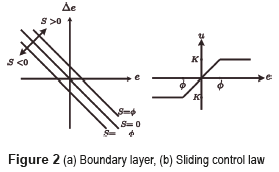
B. Fuzzy variable structure control
Fuzzy controllers can be considered as variable structure controllers due to their similarities [40, 42]. The fuzzy variable structure control is the combination of two control strategies: The fuzzy PI control [43] and the classic variable structure control, already described above.
The fuzzy PI is a fuzzy control technique where the rule matrix is already defined by the MacVicar-Whelan matrix [44], as shown in table 1.
The possible inputs are BN (Big Negative), SN (Small Negative), Z (Zero), SP (Small Positive) and BP (Big Positive). The possible outputs are Bn (Big negative), Mn (Medium negative), Zz (Zero), Mp (Medium positive) and Bp (Big positive). The membership functions for e and Δe are shown in Fig. 3.
The fuzzy VS control is basically a fuzzy PI controller with input S (S is proportional to λe plus Δe), output ''u'' and an inference rule set defined as:
1) If (S is BN) then (u is Bn)
2) If (S is SN) then (u is Mn)
3) If (S is Z) then (u is Zz)
4) If (S is SP) then (u is Mp)
5) If (S is BP) then (u is Bp)
The input set S is mapped into the output set ''u'' by the fuzzy inference system. Fig. 4 shows the relationship between the output ''u'' and the input S. This relationship is similar to the saturation function used in classic variable structure systems or in sliding control, as the one in Fig. 2b, but in this case it is usually a piecewise linear function. Hence, when the number of membership functions increases the relationship is more linear [39, 43, 45, 46].
Given the similarity between the characteristic curves for the fuzzy PI control and the classic variable structure control, it is possible to use the fuzzy PI control as a fuzzy variable structure control where the switching function can be defined as (10).

Where Kd and Ke are constant values.
Figure 5 shows the surface between the two inputs (e and Δe) and the output vsd or vsq (the surface shape is the same for both variables). These surface waveforms depend on the matrix rule and the membership functions of the cero order Takagy-Sugeno FIS.
Definition of fuzzy control techniques applied to the three phase synchronous rectifier current loop
To apply the previously discussed control strategies to the current-loop in a three phase synchronous rectifier, the line current, initially expressed in abc coordinates, is transformed to dq coordinates [47]. The current d and q components are constant in steady state, because the reference system is rotating in synchronism with ωt. In this manner, the three different control strategies will work over the direct and quadrature current components.
A. Fuzzy PI control (FVSC1)
The fuzzy PI control was implemented using a Takagi-Sugeno fuzzy inference system (FIS). The input variables are the errors in the direct and quadrature current components and their time derivatives. The universe of discourse for each input is divided into five fuzzy subsets named: BN (Big Negative), SN (Small Negative), Z (Zero), SP (Small Positive) and BP (Big Positive).
The input-output transfer rules are set following the MacVicar-Whelan rules, as shown in Table I. The same rules are used in both FIS (for the direct and quadrature components). The rule values are: Bn = -1000, Mn = -100, Zz = 0, Mp = 100 and Sp = 1000.
A zero-order Takagi-Sugeno system is used for simplicity. Hence the terms in the rules table are real and constant values, and the controller output is given by (11).

Where the weights are defined as (12).

Integration is performed summing up the output terms of the FIS as (13).

Where kidif is the integral constant and TS is the control period, equal to 100µs in this work. Fig. 6 shows a block diagram representation of the fuzzy PI controller.
B. Second order fuzzy VS control (FVSC2)
The second order fuzzy VS control is implemented with a Takagi-Sugeno FIS. In this case, the FIS input variables are multiplied by a constant. The error is multiplied by Ke, and the difference of the error by Kd, as shown in the block diagram presented in Fig. 7.
The values for Kd and Ke were heuristically selected to be 1.5 and 0.75. Those parameters adjust the input variables magnitude in a similar way as the proportional constant in classic PI controllers. The FIS used in this control algorithm is the same as the one implemented for the fuzzy PI.
C. Third order fuzzy VS control (FVSC3)
In theory, the order of a VS controller should be lower or the same as the system order. Nevertheless, here a third order fuzzy VS control is applied to a second order system (three phase synchronous rectifier). The block diagram is shown in Fig. 8.
In this case, the heuristically selected values for Kd and λ, were 2 and 0.5, respectively. Again, this technique uses the Takagi-Sugeno FIS presented in previous cases.
D. System Block Diagram
Figure 9 shows the complete block diagram for the three-phase rectifier with the fuzzy control system. The FIS input is defined in the control block. The block diagrams for the fuzzy PI, the second order variable structure and the third order variable structure controls are those already shown in figures 6, 7 and 8.
Simulations
A. Fuzzy PI Control
For this experiment, the value of kiref was set at 0.03A/V. This means that the current line amplitude should be 3% of the voltage source (approximately 5A) and the fundamental component of the current will be in phase with the line voltage, that is, the displacement factor must be 1.
Figure 10 shows the steady state line current and source voltage in phase A for the fuzzy PI Control. As can be seen, the peak current value is 5A with about 0.5V noise, and the displacement factor is 1 as required.
B. Second Order Fuzzy VS Control
Figure 11 presents the steady state line current and source voltage phase A for the Second Order Fuzzy VS Control. In this case, the same reference as the previous case is used, and as can be observed, the line current keeps in phase with the source voltage following the current reference of kiref = 0.03A/V.
C. Third order fuzzy VS control
Figure 12 shows the steady state line current and source voltage in phase A. The reference settings are the same as in the two previous cases. As can be seen, the displacement factor is also 1, but the noise level at the peak of the current waveform is about 0.75A.
Experimental results
A. Experimental Set Up
An IGBT based three phase inverter configured as a synchronous rectifier was used for the experimental tests [36]. Table 2 shows the set-up parameters that were used both in the simulations and the experimental tests. The inductor value was calculated to ensure maximum power transfer between the AC supply and the rectifier [48]. The DC-link voltage value was set to be equal to twice the value in an uncontrolled rectifier working with the same AC input.
A steady state response was obtained for the three proposed fuzzy control strategies, programmed in the test-rig. All the experiments were performed in the abc coordinates, where kiref =0.03A/V. This means that the current line amplitude should be approximately 5A when the control strategy is working, and then the displacement factor should be 1.
Figure 13 shows phase A current and voltage waveforms when no control system is applied and Fig. 14 presents the three phase current harmonic spectrum in this condition. The average total harmonic distortion for the three phases is 24.92%.
B. Fuzzy PI control
Fig. 15 shows the experimental phase A current and voltage waveforms when the fuzzy PI control is applied. As can be observed, current and voltage are in phase, with a unity displacement factor. The average total harmonic distortion for the three phases is 3.16% as shown in Fig. 16. The fuzzy PI control has achieved a harmonic reduction of about 87%.
C. Second order fuzzy VS control
Figure 17 shows the experimental phase A current and voltage waveforms when the second order fuzzy VS control is applied. As in previous case, current and voltage waveforms are in phase and the displacement factor is the unity. The average total harmonic distortion for the three phases is 2.9% as shown in Fig. 18. The second order fuzzy VS control has achieved a harmonic reduction of about 88%.
D. Third order fuzzy VS control
Figure 19 shows the experimental phase A current and voltage waveforms when the third order fuzzy VS control is applied. As before, current and voltage are in phase, with unity displacement factor. The average total harmonic distortion for the three phases is 3.57% as shown in Fig. 20. The third order fuzzy VS control has achieved a harmonic reduction of about 86%.
Conclusions
In this work, three fuzzy input current control techniques applied to a three-phase synchronous rectifier have been presented and compared. Simulations an experimental test were conducted to corroborate their performance. The three different schemes are: fuzzy PI control, second order fuzzy variable structure control and third order fuzzy variable structure control.
The input line currents were controlled applying a dq coordinate transformation and working with the direct and quadrature components, in which the control has the advantage to work with low frequency references.
The experimental responses in all techniques were similar to the simulated ones. Therefore, it can be concluded that the models used in the simulations were a precise description of the system.
The experimental results show that each of the three algorithms could compensate the displacement factor in the rectifier synchronous operation, keeping the line current in phase with the line voltage. Also, the source current harmonics are contained well within IEEE-519 limits, and the best result is obtained with FVSC2.
Additionally, it was shown that the vector rectifier, which is a second order system, can be controlled with a third order VS Control. This may be useful because there is an additional degree of freedom for better tuning.
References
1. M. Malinowski, M. Kazmierkowski, S. Hansen, F. Blaabjerg, G. Marques. ''Virtual-Flux-Based Direct Power Control of Three-Phase PWM Rectifiers''. IEEE Transactions on Industry Applications. Vol. 37. 2001. pp. 1019-1027. [ Links ]
2. X. Wu, S. Panda, J. Xu. ''DC Link Voltage and Supply-Side Current Harmonics Minimization of Three Phase PWM Boost Rectifiers Using Frequency Domain Based Repetitive Current Controllers''. IEEE Transactions on Power Electronics. Vol. 23. 2008. pp. 1987-1997. [ Links ]
3. J. Kolar, F. Zach. ''A Novel Three-Phase Utility Interface Minimizing Line Current Harmonics of High-Power Telecommunications Rectifier Modules''. IEEE Transactions on Industrial Electronics. Vol. 44. 1997. pp. 456-467. [ Links ]
4. A. Bueno, J. Aller, J. Restrepo, R. Harley, T. Habetler. ''Harmonic and Unbalance Compensation Based on Direct Power Control for Electric Railway Systems''. IEEE Transactions on Power Electronics. Vol. 28. 2013. pp. 5823-5831. [ Links ]
5. J. Restrepo, J. Viola, J. Aller, A. Bueno. A Simple Switch Selection State for SVM Direct Power Control. Proceedings of the IEEE International Symposium on Industrial Electronics. Montreal, Canada. 2006. pp. 1112-1116. [ Links ]
6. T. Noguchi, H. Tomiki, S. Kondo, I. Takahashi. ''Direct Power Control of PWM Converter without Power-Source Voltage Sensors''. IEEE Transactions on Industry Applications. Vol. 34. 1998. pp. 473-479. [ Links ]
7. L. Moran, L. Dixon, R. Wallace. ''A Three-Phase Active Power Filter Operating with Fixed Switching Frequency for Reactive Power and Current Harmonic Compensation''. IEEE Transactions on Industrial Electronics. Vol. 42. 1995. pp. 402-408. [ Links ]
8. S. Rahmani, N. Mendalek, K. Al-Haddad. ''Experimental Design of a Nonlinear Control Technique for Three-Phase Shunt Active Power Filter''. IEEE Transactions on Industrial Electronics. Vol. 57. 2010. pp. 3364-3375. [ Links ]
9. V. Valouch. Fuzzy Power Control in PWM Voltage-type Rectifier. Proceedings of the IEEE International Symposium on Industrial Electronics (ISIE '97). Guimarães, Portugal. 1997. pp. 1162-1167. [ Links ]
10. A. Bouafia, F. Krim, J. Gaubert. ''Fuzzy-Logic-Based Switching State Selection for Direct Power Control of Three-Phase PWM Rectifier''. IEEE Transactions on Industrial Electronics. Vol. 56. 2009. pp. 1984-1992. [ Links ]
11. A. Bouafia, F. Krim, J. Gaubert. Direct Power Control of Three-Phase PWM Rectifier Based on Fuzzy Logic Controller. Proceedings of the IEEE International Symposium on Industrial Electronics (ISIE). Cambridge, UK. 2008. pp. 323-328. [ Links ]
12. J. Xu, J. Zhao, L. Luo, X. Ma, S. Wan. A New Control Strategy of Unity Power Factor for Three-Phase PWM Rectifier System. Proceedings of the 30th Annual Conference of IEEEIndustrial Electronics Society (IECON). Busan, South Korea. 2004. pp. 709-714. [ Links ]
13. A. Shoulaie, P. Ramezanpoor, H. Amirkhani. Control of Multilevel-Inverters for Active Power Filters Using a Fuzzy Space-Vector Method. Proceedings of the IEEE International Symposium on Industrial Electronics (ISIE '97). Guimarães, Portugal. 1997. pp. 279-282. [ Links ]
14. T. Lee, D. Tzeng. Repetitive Learning Control with Fuzzy Tuning for Three-Phase Shunt Active Power Filters in Stationary d-q Frame. Proceedings of the International Power Engineering Conference (IPEC). Singapore, Singapore. 2007. pp. 1059-1064. [ Links ]
15. J. Norniella, J. Cano, G. Orcajo, C. Rojas, F. Gonzalez, M. Cabanas, M. Melero. ''Improving the Dynamics of Virtual Flux-Based Control of Three-Phase Active Rectifiers''. IEEE Transactions on Industrial Electronics. Vol. 61. 2014. pp. 177-187. [ Links ]
16. M. Malinowski, M. Jasinski, M. Kazmierkowski. ''Simple Direct Power Control of Three-Phase PWM Rectifier Using Space-Vector Modulation (DPC-SVM)''. IEEE Transactions on Industrial Electronics. Vol. 51. 2004. pp. 447-454. [ Links ]
17. J. Restrepo, V. Guzmán, M. Giménez, A. Bueno, J. Aller. ''Parallelogram Based Method for Space Vector Pulse Width Modulation''. Revista Facultad de Ingeniería Universidad de Antioquia. N.° 51. 2010. pp. 161-171. [ Links ]
18. T. Lee, D. Tzeng, M. Chong. Fuzzy Iterative Learning Control for Three-Phase Shunt Active Power Filters. Proceedings of the IEEE International Symposium on Industrial Electronics. Montreal, Canada. 2006. pp. 882-885. [ Links ]
19. A. Luo, X. Xu, H. Fang, H. Fang, J. Wu, C. Wu. ''Feedback-Feedforward Pi-type Iterative Learning Control Strategy for Hybrid Active Power Filter with Injection Circuit''. IEEE Transactions on Industrial Electronics. Vol. 57. 2010. pp. 3767-3779. [ Links ]
20. X. Du, L. Zhou, H. Lu, H. Tai. ''DC Link Active Power Filter for Three-Phase Diode Rectifier''. IEEE Transactions on Industrial Electronics. Vol. 59. 2012. pp. 1430-1442. [ Links ]
21. G. Nageswara, K. Chandra, P. Sangameswara. ''Three Phase Active Power Filter Controller for Balanced and Unbalanced Non-linear Load''. International Journal of Engineering Science and Technology. Vol. 2. 2010. pp. 4072-4082. [ Links ]
22. I. Habi, M. Bouguerra, D. Ouahdi, H. Meglouli. ''Using the Shunt Active Power Filter for Compensation of the Distorted and Unbalanced Power System Voltage''. World Academy of Science, Engineering and Technology. Vol. 24. 2008. pp. 980-984. [ Links ]
23. M. SajediHir, Y. Hoseinpoor, P. MosadeghArdabili, T. Pirzadeh. ''Analysis and Simulation of a d-statcom for Voltage Quality Improvement''. Australian Journal of Basic and Applied Sciences. Vol. 5. 2011. pp. 864-870. [ Links ]
24. B. Singh, S.. Arya. ''Design and Control of a d-statcom for Power Quality Improvement Using Cross Correlation Function Approach''. International Journal of Engineering, Science and Technology. Vol. 4. 2012. pp. 74-86. [ Links ]
25. C. Sao, P. Lehn, M. Iravani, J. Martinez. ''A Benchmark System for Digital Time-Domain Simulation of a Pulse-Width-Modulated d-statcom''. IEEE Transactions on Power Delivery. Vol. 17. 2002. pp. 1113-1120. [ Links ]
26. V. Singhal. ''Fuzzy Pre-Compensated Pi Control of Active Filters''. Journal of Power Electronics. Vol. 8. 2008. pp. 141-147. [ Links ]
27. W. Dai, B. Wang, Y. Xie. A Novel Fuzzy Logic Controller for Active Power Filter. Proceedings of the IEEE International Conference on Computational Intelligence for Measurement Systems and Applications, (CIMSA '09). Hong Kong, China. 2009. pp. 118-123. [ Links ]
28. C. Bhende, S. Mishra, S. Jain. ''Ts-Fuzzy-Controlled Active Power Filter for Load Compensation''. IEEE Transactions on Power Delivery. Vol. 21. 2006. pp. 1459-1465. [ Links ]
29. X. Dianguo, H. Na, W. Wei. Study on Fuzzy Controller with a Self-Adjustable Factor of Active Power Filter. Proceedings of the 32nd Annual Conference on Industrial Electronics (IECON). Paris, France. 2006. pp. 2226-2231. [ Links ]
30. Y. Dongmei, G. Qingding, H. Qing, L. Chunfang. A Novel DSP Based Current Controller with Fuzzy Variable-Band Hysteresis for Active Power Filters. Proceedings of the IEEE/PES Transmission and Distribution Conference and Exhibition: Asia and Pacific. Dalian, China. 2005. pp. 1-5. [ Links ]
31. Y. Chen, B. Fu, Q. Li. Fuzzy Logic Based Auto-Modulation of Parameters Pi Control for Active Power Filter. Proceedings of the 7th World Congress on Intelligent Control and Automation (WCICA). Chongqin, China. 2008. pp. 5228-5232. [ Links ]
32. W. Gu, W. Yu. Research of Three Phase Shunt Active Power Filter Based on Fuzzy-Sliding Variable Structure Control. Proceedings of the IEEE International Conference on Control and Automation (ICCA). Guangzhou, China. 2007. pp. 294-298. [ Links ]
33. A. Berzoy, M. Strefezza. Fuzzy Variable Structure Controller for a Three-Phase Rectifier with Power Factor Correction. Proceedings of the ICCAS-SICE. Fukuoka, Japan. 2009. pp. 412-417. [ Links ]
34. A. Berzoy, M. Strefezza. ''Optimized Fuzzy Variable Structure for a Three-Phase rectifier with power factor correction''. WSEAS Transactions on Power Systems. Vol. 4. 2009. pp. 275-284. [ Links ]
35. A. Berzoy, E. Baethge, J. Restrepo, J. Viola. Fuzzy Control System for Maximum Power Point Tracking in Solar Panels Based on DC-DC Converter Pi Current Control. Proceedings of the VI Andean Region International Conference (ANDESCON). Cuenca, Ecuador. 2012. pp. 119-122. [ Links ]
36. M. Giménez, V. Guzmán, J. Restrepo, J. Aller, A. Bueno, J. Viola, A. Millán, A. Cabello. ''Plataforma: Development of an Integrated Dynamic Test System to Determine Power Electronics Systems Performance''. Revista de la Facultad de Ingeniería U.C.V. Vol. 23. 2008. pp. 91-102. [ Links ]
37. H. Komurcugil. ''Rotating-Sliding-Line-Based Sliding-Mode Control for Single-Phase UPS Inverters''. IEEE Transactions on Industrial Electronics. Vol. 59. 2012. pp. 3719-3726. [ Links ]
38. M. Curkovic, K. Jezernik, R. Horvat. ''FPGA-Based Predictive Sliding Mode Controller of a Three-Phase Inverter''. IEEE Transactions on Industrial Electronics. Vol. 60. 2013. pp. 637-644. [ Links ]
39. J. Jang, C. Sun, E. Mizutani. ''Neuro-Fuzzy and Soft Computing-a Computational Approach to Learning and Machine Intelligence [book review]''. IEEE Transactions on Automatic Control. Vol. 42. 1997. pp. 1482-1484. [ Links ]
40. D. Driankov, H. Hellendoorn, M. Reinfrank. An Introduction to Fuzzy Control. 1sted. Ed. Springer-Verlag. Berlin, Germany. 1993. pp. 307. [ Links ]
41. R. Yager, D. Filev. Essentials of Fuzzy Modeling and Control. 1st ed. Ed. John Wiley and Sons. New York, USA. 1994. pp. 408. [ Links ]
42. V. Raviraj, P. Sen. ''Comparative Study of Proportional-Integral, Sliding Mode, and Fuzzy Logic Controllers for Power Converters''. IEEE Transactions on Industry Applications. Vol. 33. 1997. pp. 518-524. [ Links ]
43. G. Mann, B. Hu, R. Gosine. ''Analysis of Direct Action Fuzzy PID Controller Structures''. IEEE Transactions on Systems, Man, and Cybernetics, Part B: Cybernetics. Vol. 29. 1999. pp. 371-388. [ Links ]
44. A. Visioli. ''Fuzzy Logic Based Set-Point Weight Tuning of PID Controllers''. IEEE Transactions on Systems, Man and Cybernetics, Part A: Systems and Humans. Vol. 29. 1999. pp. 587-592. [ Links ]
45. H. Li, H. Gatland, A. Green. ''Fuzzy Variable Structure Control''. IEEE Transactions on Systems, Man, and Cybernetics, Part B: Cybernetics. Vol. 27. 1997. pp. 306-312. [ Links ]
46. A. Kandel, G. Langholz. Fuzzy Control Systems. 1sted. Ed. CRC Press. Florida, USA. 1994. pp. 656. [ Links ]
47. R. Park. ''Two-Reaction Theory of Synchronous Machines Generalized Method of Analysis-part I''. Transactions of the American Institute of Electrical Engineers. Vol. 48. 1929. pp. 716-727. [ Links ]
48. J. Das. Power System Analysis: Short-Circuit Load Flow and Harmonics. 1st ed. Ed. CRC Press. New York, USA. 2002. pp. 831. [ Links ]













